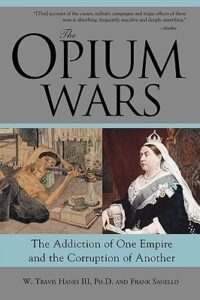

Table of Contents
Chapter 1. Lord Elgin’s Revenge
“All the diamonds in the world are as nothing compared to what comes from the East.”
—Austrian Empress Maria Teresa
- By 1860, Great Britain had achieved military, literary, and artistic ascendancy, marked by cultural achievements such as Dickens’ “Great Expectations,” Darwin’s “On the Origin of Species,” and the launch of the Arts and Crafts movement by William Morris.
- The destruction of the Summer Palace in China, the Yuan Ming Yuan, occurred in 1860 during the second Opium War between Britain and China.
- The Summer Palace, established in 1709, covered around eighty square miles and housed over two hundred buildings with gardens in various Chinese styles.
- The Qianlong Emperor’s careful attention turned the Summer Palace into a repository of Chinese treasures, rivaling Versailles in formal greenery.
- The destruction of the Summer Palace was orchestrated by James Bruce, the eighth Earl of Elgin, Britain’s plenipotentiary to China.
- The looting and destruction occurred on October 18, 1860, with systematic burning of the palace structures.
- Prior looting by French and British soldiers had already depleted many valuable artifacts, and the remaining treasures were taken or destroyed during the final destruction.
- Despite looting and destruction, some artifacts, such as books from the Imperial library, were saved and transported to the British Museum.
- The Summer Palace contained various treasures, including bronzes, enamels, clocks, silks, furs, jade, and historical artifacts given as gifts by King George III to the Qianlong Emperor.
- The decision to destroy the Summer Palace was controversial, with some officers, like Sir John Michel, sparing certain structures for their artistic value.
- The destruction left the Summer Palace in ruins, described as a “dreary waste of ruined nothings” and a “scene of confusion and desolation.”
- The destruction had economic implications, with some officers expressing discomfort and regret for the loss of cultural heritage.
- The Yuan Ming Yuan, once a living museum, burned for two days, sending black smoke and ashes across the capital, symbolizing the Emperor’s shame.
↔↔↔↔↔↔↔↔↔↔↔
- Lord Elgin’s decision to set fire to the Summer Palace was in retaliation for the mistreatment of English and Indian prisoners of war (POWs).
- In September 1860, around twenty French and British soldiers were captured by the Chinese, and diplomats Harry Parkes and Henry Loch were arrested under a flag of truce during negotiations.
- Parkes and Loch were subjected to brutal treatment, including repeated head-banging on the marble floor and being forced to kneel without food or water.
- Leather straps bound their hands and feet, causing wounds that became infected, attracting maggots that gnawed on the open sores.
- Twenty out of the thirty-nine European prisoners died during their month of captivity, with The Times correspondent Thomas Bowlby among the casualties.
- Lt. Anderson, another prisoner, begged his comrades to bite off his restraints in a delirious state but died after nine days of confinement.
- Sikh cavalryman Bughel Sing testified that Anderson’s hands swelled and turned black from gangrene, and Bowlby died from maggots forming in his wrists.
- The Chinese left Bowlby’s corpse to rot for three days in the cell before tying it to a wooden cross and throwing it over the city walls, where it was devoured by dogs and pigs.
- Other prisoners suffered gruesome fates, such as maggots invading ears, nose, and mouth, and hands bursting under the pressure of leather bands.
- A French prisoner went mad due to maggot infestation, and a Sikh’s hands were completely eaten away before his death.
- Indian prisoners were forced to commit sacrilege, with one being compelled to eat pork, and Lt. Anderson persuaded Hindu prisoners to eat beef when food was finally provided by their jailers.
↔↔↔↔↔↔↔↔↔↔↔
- Lord Elgin chose the Summer Palace for retaliation against Chinese war crimes, seeing it as a personal possession of the emperor.
- He believed the Winter Palace in the Forbidden City was the national capital, sparing it from destruction to convey blame solely on the emperor.
- Elgin posted a proclamation in Chinese, justifying the burning of Yuan-Ming-Yuan as punishment for the violation of the flag of truce.
- Elgin’s view of the emperor as personally responsible for POW mistreatment might be based on inaccurate information about the emperor’s role in governance.
- Elgin’s concern for Chinese feelings displayed little understanding of Chinese sensibilities, and the Chinese reportedly laughed at the proclamation’s bad grammar.
- The conscientious act of vandalism aimed at a debauched emperor fueled Chinese resentment and reinforced the perception of Europeans as barbarians.
- The act further poisoned relations between China and the West, contributing to Chinese resistance against Western encroachment for the next century and a half.
- A year later, Lord Elgin expressed regret for the destruction at the Royal Academy but dismissed the value of China’s aesthetic achievements over two thousand years.
- Elgin downplayed the artistic contributions of China, describing them as “cynical representations of the grotesque” and expressed belief in hidden sparks of divine fire that could be nurtured by the genius of his countrymen.
- Despite his regret, Elgin received cheers from England’s intelligentsia and academe for burning down the Emperor’s Summer Palace.
↔↔↔↔↔↔↔↔↔↔↔
- The conflicts surrounding the violations of the flag of truce and the destruction of the Summer Palace were rooted in deeper issues.
- Britain aimed to force China into the modern, industrial global economy against their will.
- The use of opium as a major import for exchanging with China’s silk and tea was a tactic vehemently opposed by the Chinese.
- Two wars were imposed by the British within two decades to establish the sale of opium in China and gain recognition as an equal trading nation.
- The underlying conflict went beyond economic interests; it marked a cultural confrontation between two civilizations—one ancient (China) and one new (Britain).
- The burning of the Summer Palace symbolized both a culmination and a new beginning in this larger cultural confrontation.
- The clash involved two civilizations, each considering itself the pinnacle of global civilization.
- The roots of this conflict could be traced back nearly a century before the events surrounding the Summer Palace.
